| Patriot Outreach Supporting all Military Service Men, Women, Retirees, Veterans, Government Civilians, Battlefield Contractors and their Families. |
| Home | My Story | Get Help | What's Happening | About Stress & PTSD | News & Reports | Donate | Mission | Contact |
FM 22-51
LEADERS' MANUAL FOR COMBAT STRESS CONTROL
CHAPTER 9
COMBAT STRESS CONTROL IN OPERATIONS OTHER THAN WAR
9-1. Introduction
The Army classifies its activities during peacetime and conflict as operations other than war.
Conflict is characterized by hostilities short of war to secure strategic objectives.
a. The growing incidence of conflict pits Army forces against irregular or unconventional
forces, enemy special operations forces (SOF) and terrorists. Conflict poses a threat to
US interests at all times, not just in periods of active hostilities. United States citizens,
especially military personnel and their families, may be at risk anywhere in the world.
b. The terrorist or guerrilla forces count on fear and terror as their principal weapon and
objective. By attacking the defending military forces and civilian population only at times
and places of their choosing, they deny the defender any safe areas and flaunt the
inability of the authorities to protect themselves or their people. By hiding among the
populace and using women and children as combatants, the guerrilla or terrorist provokes
the defending forces to perceive the people as unworthy of protection. The defender may
adopt harsh repressive measures and commit atrocities which turn the people against the
defenders.(1) Although the stressors of terrorism and guerrilla tactics are less overwhelming
than those of war, they are deliberately designed to cause breakdown of military
professionalism and discipline. As these events are reported in the media, the
enemy expects that the home front in the US will perceive the conflict as
unwinnable and immoral. The goal for the enemy is for the US home front to
abandon support for the effort and even turn against our own soldiers.
(2) In operations other than war when combat operations are required
(engagements), battle fatigue casualty rates rarely exceed one battle fatigue
casualty per ten WIA. Other misconduct stress behaviors, including drug and
alcohol abuse and criminal acts, become the more common and serious reflectors
of combat stress in light combat operations. Table 9-1, page 9-3, lists some likely
stress-producing aspects of operations other than war which involve conflict.
(3) Civil and military leaders would be in error to rely only on military technology
and indiscriminate firepower to oppose a guerrilla force. These leaders must also
recognize and defuse the political and psychological stress threat. If they fail to do
this, they may win the battles in the field but still lose the war (or the post-treaty
peace).c. Forces for military operations other than war must be selected and task-organized to fit
the situation. Combat, when it occurs, is strategically defensive and intended to permit
political, social, and economic development activities. The nature of the conflict requires
that coercive measures be the minimum necessary to achieve the purpose. This will be
visible to the soldier largely in terms of extremely restrictive rules of engagement. For his
own sake, as well as for the success of the mission, the soldier must understand the
environment in which he is to operate and fight.(1) Army actions in operations other than war must be fully coordinated with
national strategy and fused at the operational level into a coherent effort. The
effort must complement economical, political, and military activities. This linkage
with such activities must be made clear to the soldiers. Failure to do so can lead to
confusion and frustration among soldiers as to the purpose, attainability, and
objectives of their mission.
(2) Public affairs plays a critical role in the operations other than war
environment, across all of the operational categories. It supports the commander
and soldier by --
- Assessing information needs.
- Formulating messages.
- Facilitating the flow of information.
- Providing communications channels.
- Serving as the primary interface between the military and the civilian
media.A key public affairs mission is to reduce the soldiers' sense of isolation by --
- Reinforcing the role each soldier plays in the operation.
- Ensuring information flows in and out of the theater.
- Telling the Army story to the public in order to maintain support for the
effort and the soldiers.(3) Operations other than war (peacetime or conflict) require that the plan and the
task organization of units be tailored to the specific operation. The following
paragraphs review the operational categories and the special stressors that soldiers
are likely to encounter.
9-2. Support for Insurgency Operations
a. Support for insurgency is a goal-directed activity. These operations are normally of
long duration and predominantly conducted by indigenous or surrogate forces. These
forces are organized, trained, equipped, supported, and directed in varying degrees by an
outside source. Unconventional warfare, a tactic employed in insurgency or
counterinsurgency, includes guerrilla warfare and other direct offensive, low-visibility,
covert, or clandestine operations. It also includes the indirect activities of subversion,
sabotage, intelligence collection, evasion, and escape. The primary forces used in
unconventional warfare are SOF. Combat stress control personnel who support such
operations must have the appropriate level of security clearance to debrief and treat SOF
personnel at the conclusion of their mission.
b. Insurgency is an organized, armed, political struggle whose goal may be the seizure of
power through revolutionary takeover and the replacement of the existing government. In
some cases, however, insurgency is undertaken to break away from government control
and establish an autonomous state within traditional ethnic or religious territorial bounds.
It may even be conducted to extract limited political concessions that are unattainable
with less violent means.(1) The existing government will attempt to isolate the insurgents from the
general population. Therefore, insurgents normally must live under austere or
primitive conditions, have limited or no access to medical care, and often operate
using hit-and-run tactics. The severity of those conditions will depend upon how
much support the insurgents receive from the local population and the
effectiveness of the government's repressive measures.
(2) If the US SOF were to provide support to a US-backed insurgent group, they
would also operate and live in this austere environment. Issues which would
contribute to combat stress, battle fatigue, and potential misconduct stress
behaviors are listed in Table 9-2 along with leader and buddy actions to
counteract these stressors.
Table 9-1. Stress-Producing Aspects of Operations Other Than War (Conflict)
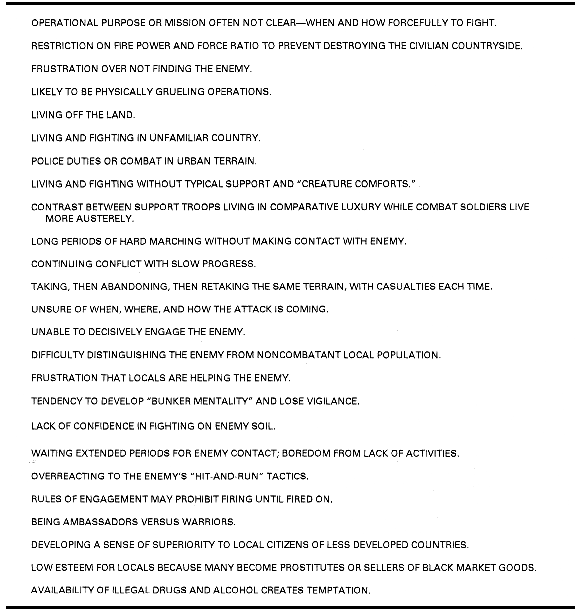
(3) Insurgents frequently adopt terrorism as a tactic. This is one of the things that
makes counterinsurgency so difficult. It also makes support for insurgency
(should we be called upon to do it) such a moral dilemma.
(4) Insurgencies and use of terrorism independent of insurgencies probably pose
stress which is as severe as that which occurs in the most violent of
"conventional" wars. All the societal norms which Americans accept seem to be
abandoned and perhaps irrelevant. The participants' moral compass may go
haywire so that they have a hard time distinguishing right from wrong. Innocent
persons are singled out for the most atrocious attacks because of their shock
value.
(5) Inspired, compassionate leadership and firm discipline are required to prevent
misconduct stress behaviors.
Table 9-2. Stress Considerations and Recommendations for Stress Control in Insurgency
Operations
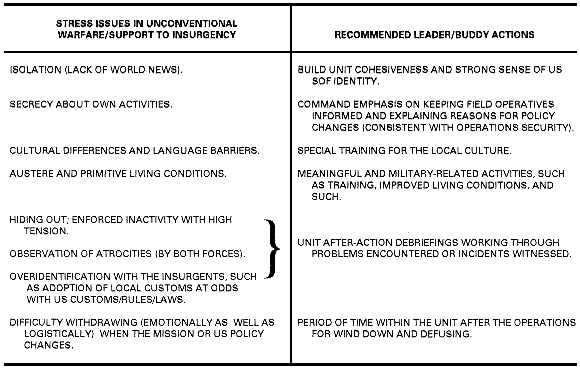
9-3. Support for Counterinsurgency Operations
Internal Defense and Development (IDAD) strategy is the full range of measures taken by a
nation to promote its growth and protect itself from subversion, lawlessness, and insurgency. It
focuses on building viable institutions (political, economic, military, and social) that respond to
the needs of the society. Developmental programs, carefully planned, implemented, and
publicized, can serve the interests of population groups and deny exploitable issues to the
insurgents. Foreign Internal Defense (FID) is the participation by civilian and military agencies
of a government in any of the action programs taken by another government to free and protect
its society. Foreign Internal Defense is the US role in the IDAD strategy.
a. In countering an insurgency, the Army may employ specially trained forces or training
teams. This sort of activity may include the transfer of defense equipment, the training of
foreign soldiers, advisory assistance, or even the commitment of combat forces. All
military efforts in a counterinsurgency campaign will be made in concert with the HN
and the initiatives of other US government agencies involved to ensure a synchronized
national effort.b. The forces selected for FID will depend on the threat to be countered. Special
operations forces, light and heavy forces, aviation units, logistical support, and a variety
of training teams may be used for counterinsurgency efforts.c. The high degree of selection and training, provided it is done well, tends to minimize
battle fatigue casualties and misconduct stress behaviors. However, if units are hastily
selected and deployed, they are likely to have problems facing the special stressors in
operations other than war (listed in Table 9-1).
d. Refer to Table 9-3 for mental health considerations and recommendations in support of
counterinsurgency operations.
9-4. Combatting Terrorism
a. Terrorism and the threat of terrorism are widespread in the modern world. Terrorism
can occur throughout the operational continuum. It is defined as the unlawful use or
threatened use of force or violence against people or property to coerce or intimidate
governments or societies, often to achieve political, religious, or ideological objectives.(1) Terrorists may be independent groups or may be supported covertly or openly
by hostile states. Terrorist organizations sometimes cooperate with each other in
pursuit of common strategic objectives.
(2) US Army doctrine calls for preventive action (antiterrorism) along with
reactive measures (counterterrorism) to meet the terrorist threat to US forces,
representatives, and agencies and to the security of American citizens and
property.(a) Antiterrorism consists of those defensive measures used to reduce the
vulnerability of personnel, family members, facilities, and equipment to
terrorist acts.
(b) Counterterrorism is comprised of those offensive measures taken to
prevent, deter, and respond to terrorism. Terrorism must be dealt with in
the Army's daily operations as well as being of concern in war and
operations other than war. Terrorist tactics may be directed at service
families, recreational facilities, and general targets such as commercial
airliners.
Table 9-3. Stress Considerations andand Recommendations for Stress Control in
Counterinsurgency Operations
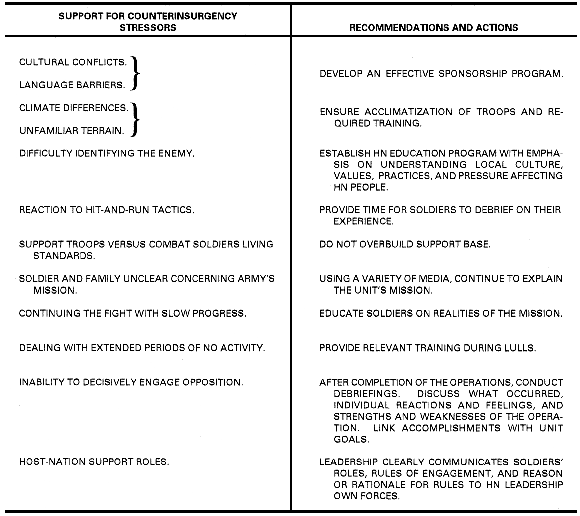
(c) Awareness of the threat and recognition that the indicators of terrorist
activity differ from those of the enemy on the conventional battlefield are
essential to combatting terrorism.
(d) Leaders at all levels must develop a broad view of this threat which
will guide them in securing their operations and in protecting their soldiers
from terrorists as well as from conventional enemy military forces.
(e) At the same time, they must not impose excessive anxiety, restrictions,
and repression which play into the enemies' game plan.(3) United States counterterrorism forces must be protected against and treated for
combined effects offrustration, moral conflict, and boredom which are the
terrorists' main goals for success. When implementing preventive or reactive
programs, the following should be considered:
- Battle fatigue is usually mild and can be managed in the units.
- Special programs may be needed to prevent and treat alcohol and drug
misuse.- Additional programs may be required to prevent misconduct against
prisoners or noncombatants and other lapses of military discipline.- Soldiers who return from counterterrorism missions and other special
operations need a stand-down period. This should come before they are
reunited with their families or other noncombatants. The stand-down
period is needed to "defuse" the tension that has built up during the
operational phase. These programs are also needed to protect against
PTSD which may disable the soldier or veteran for several months or
years after returning home.b. Terrorist acts produce debilitating stress reactions due to the shock of the event, the
sudden violation of familiar and safe settings, and the feeling of loss of control. The
stress may impact not only on the direct victims of the terrorist act but also on the passive
witnesses of the destruction, the immediate rescuers and care givers, and the more distant
care givers, friends, coworkers, and family. The following feelings or behaviors may
become evident:
- Hostile feelings (repressed or expressed).
- Feelings of dependence.
- Feelings of powerlessness or incompetence.
- Regressive behaviors (childish temper outbursts, stubbornness).
- Negative responses to relocation and isolation.
- Positive identification with the terrorists ("the Stockholm syndrome").
- Sense of being a victim.
- Negative feelings about one's own country or its allies.
c. Victims of disaster/hostage/terrorist situations suffer a high incidence of acute, chronic,
and delayed PTSD in addition to possible medical and surgical injuries. Treatment of
these disorders in the acute phase, and even better, preventive measures before symptoms
occur, can prevent the development of many chronic or delayed disabilities.(1) Task-organized multidisciplinary stress control teams provide mental health
treatment services. These teams initiate preventive treatment measures to
individuals or groups involved in disasters, terrorist activities, and hostage
situations. Teams are task-organized depending upon the number of people
involved in the specific incident and the nature of the incident.
(2) The team assists victims, family members, witnesses, immediate rescuers, and
backup medical staff involved in terrorist or hostage situations. A variety of
individual and group techniques are used to help return persons to normal
functions and to reduce the impact of PTSD. Some examples of these techniques
are as follows:
- Professional reassurance of the normality of acute stress reactions and the
positive expectation of rapid recovery and coping.- Critical event debriefing of groups. Everyone is encouraged to talk out
what happened and what everyone did (saw, heard, smelled, felt) in detail. In the process, the group corrects misunderstandings and validates
and ventilates feelings.- Individual debriefing as needed.
- Extremely limited use of fast-acting sedating medication in special cases.
- Individual, group, or family follow-up as needed.
d. Refer to Table 9-4 for some operations other than war mental health recommendations
in support of combatting terrorism.
Table 9-4. Stress Considerations and Recommendations for Stress Control Issues -- Related to
Terrorist Attacks
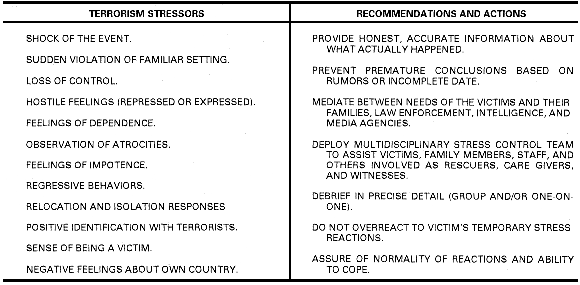
9-5. Operations Other Than War (Peacetime Contingency Operations)
These operations are politically sensitive military activities. They are normally characterized by
the short-term, rapid projection or employment of forces in operations other than war. They are
often undertaken in crisis avoidance or crisis management situations requiring the use of military
instruments to enforce or support diplomatic initiatives.
a. Several Types of Operations. There are numerous types of operations which are
covered by this operational category. In each type of operation, different stress factors
will be present. Some operations, such as strikes and raids, inherently involve combat,
but are brief. Others, such as peacemaking and noncombatant evacuation operations, run
a high risk of violence but under much more ambiguous conditions. Military operations
other than war such as peacekeeping, nation building, and disaster relief should not lead
to combat, but do involve their own types of stressors. Soldiers are expected to be
ambassadors and representatives of the goodwill of the US, yet they may be separated
from home or family, sometimes abruptly. They may have to live under uncomfortable or
monotonous, boring conditions, perhaps for prolonged periods. In addition, they may be
exposed to an entirely different culture whose practices may seem alien, backward, or
even repulsive to those who do not understand the historical or practical reasons for them.
However, misconduct stress behaviors on the part of our troops can turn local goodwill
into enduring resentment and hatred. Table 9-5 provides some of the mental health
considerations which may be present in any given peacetime contingency situation and
recommended actions which may be taken. Each type of operation is presented below.
b. Attacks and Raids. The US conducts attacks and raids for specific purposes other than
gaining or holding terrain. Attacks and raids can support rescue and recovery operations.
They can destroy or seize equipment or facilities which significantly threaten national
security interests. They can also support counter-drug operations by destroying narcotics
production or temporary storage facilities used during shipment, or support HN's actions
in this regard. Depending on the intensity and duration of combat and on the success (or
lack of success), strikes and raids produce traditional combat stress behaviors. The level
of secrecy in which the operation is conducted can produce added stress for the soldier
and his family. Depending on the size and planned duration of the operation, mental
health/combat stress control personnel may accompany the strike force or remain at home
station. Mental health/combat stress control personnel should be involved as early as
feasible in planning and recovery.
c. Shows of Force and Demonstrations. These operations lend credibility to our nation's
promises and commitments. They increase our regional influence and demonstrate our
resolve to use military force as an instrument of national power. Further, the NCA may
order these operations to bolster and reassure friends and allies. Health service support
activities to include combat stress control follow the traditional role of providing support
to a combat force. Demonstrations may involve high anticipatory anxiety but usually do
not cause psychic trauma unless open combat, accidental deaths, or terrorist acts result
from them.
d. Rescue and Recovery Operations. Rescue and recovery operations are sophisticated
actions requiring precise execution, especially when conducted in a hostile environment.
These operations may be clandestine or overt. They may include the rescue of US troops
or friendly foreign nations, or the location, identification, and recovery of sensitive
equipment or items critical to US national security. The level of hostilities to be
encountered will vary with each specific mission. Mental health support may be required
by the individuals being rescued or the force employed. The level of security for the
operation may result in added stressors to those accomplishing the mission.
Table 9-5. Stress Considerations and Recommendations for Stress Control in Peacetime
Contingency Operations
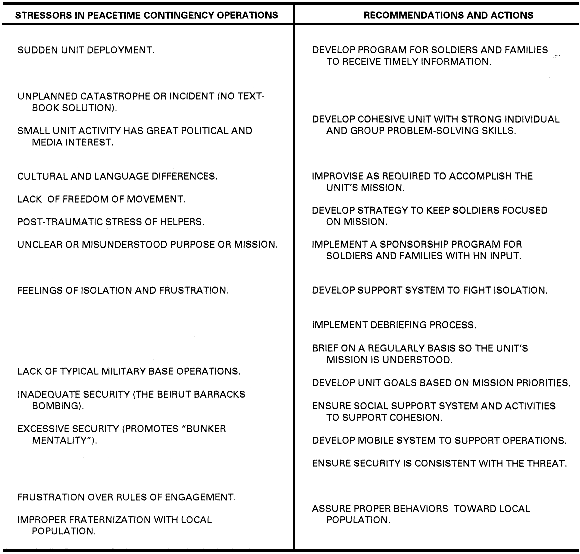
e. Disaster Relief Operations. Disaster relief operations provide emergency assistance to
victims of natural and man-made disasters abroad. These operations are responses to
requests for immediate help and rehabilitation from foreign governments or international
agencies. Mental health support may be required for both victims of the disaster and the
military units and health professionals caring for them. The victims' plight may be truly
distressing and leave memories of many horrible sights, sounds, and smells for all
involved. Recent disasters within the US have also expanded the role of the military
(Active and Reserve Components) in domestic disaster relief. In some instances,
identification with the victims may even be stronger. For some units, their own families
may be involved in the disaster while they must remain on duty for the common good.
f. Noncombatant Evacuation Operations. Noncombatant evacuation operations are
conducted to relocate civilian noncombatants from locations in a foreign country. These
operations are normally conducted to evacuate US citizens whose lives are in danger;
however, they may also include the evacuation of HN or third country citizens. These
operations are of short duration. They consist of rapidly inserting a force, occupying an
objective, and making a planned withdrawal. The amount of force used is normally
limited to that required for self-defense and the defense of the operations. Mental health
support may be required for both the forces employed and the civilians being evacuated.
The need for mental health intervention will depend upon the level of hostilities and the
psychological trauma encountered. It also depends on the anticipated duration of the
operation and the recent experiences of those being evacuated. After-action debriefing at
the small unit level should be routine. All evacuees should receive large group stress
debriefing. Critical event debriefings can then be scheduled for such groups who need
them.
g. Operations to Restore Order ("Peacemaking''). These operations are intended to
establish and restore peace and order through the use of force. The US conducts these
operations when it is in its national interest. Intense efforts are made to stop a violent
conflict and to force a return to political and diplomatic methods of resolution. The US
typically undertakes "peacemaking" operations at the request of appropriate national
authorities in a foreign country. It may also conduct these operations to protect US
citizens as part of an international, multilateral, or unilateral operation. The threat of
armed resistance or attack by one or more disgruntled parties in the conflict is high. This
may take the form of overt battle, major terrorist attack, or covert harassment and
sniping. The rules of engagement may require not returning fire until fired upon, with the
source of hostile fire clearly identified. Combat stress control support for peacemaking
forces requires the traditional support to combat forces. Peacemaking forces must also be
prepared to counter added stressors. These stressors may include language and customs
barriers, ambiguous threats, and the lack of freedom of movement.
h. Peacekeeping Operations. Peacekeeping operations are military operations conducted
with the consent of the belligerent parties to a conflict. These operations are conducted to
maintain a negotiated truce and to facilitate a diplomatic resolution. The US may
participate in peacekeeping operations under the auspices of an international
organization, in cooperation with other countries, or unilaterally. Peacekeeping
operations support diplomatic efforts to achieve, restore, or maintain peace in areas of
potential or actual conflict. Units of peacekeeping forces may use force only in clear
cases of self-defense. Due to the nature of peacekeeping operations, misconduct stress
behaviors can result from a number of factors. Another characteristic of peacekeeping is
isolation of small units for prolonged periods with only radio or telephone contact with
their superiors. Also, any violence directed against the peacekeepers will likely come
from people whom they intend to be helping. Thus, a sense of betrayal aggravates the
stress inherent in the event. Table 9-6 provides mental health considerations and
recommendations in support of peacekeeping operations.
i. Humanitarian and Civic Assistance. US Army combat support/CSS units may be
deployed or rotated to friendly HNs to assist that country in developing its resources.
These activities serve the basic economic and social needs of the people of the country
concerned. They --
- Support the civilian leadership.
- Benefit a wide spectrum of the community.
- Should be self-sustaining (once completed) or supportable by the HN civilian or
military agencies. Examples include --
- Providing medical, dental, and veterinary care in rural areas.
- Training local health care personnel in hygiene and preventive medicine.
- Assisting in establishing mental health and social service agencies.
- Performing engineer projects, such as building roads, bridges, and flood
control dams.Army units engaged in humanitarian and civic assistance range from active Army units
deployed for relatively long periods to Reserve Component units on annual training.
These conditions can cause a wide variety of stressors related to acclimatization to the
environment and culture, coupled with separation from home.
9-6. Stress Problems of Military Operations Other Than War
The stress problems of military operations other than war are recognized by Army long-range
planners. The Army must develop an appreciation of low-key, frustrating, and frequently
unglorious work. This will not be easy for our soldiers from a culture noted for its impatience
and thirst for decisive outcomes. In some areas, we may have to "train down" to less
sophisticated equipment because operations other than war frequently are not appropriate for
displaying the latest technology. Finally, there is the matter of culture. The American sent to
function in an alien culture will have to possess some knowledge of that culture if he is to
successfully interact with and influence the members of that culture. For additional information
on operations other than war and peacetime contingency operations, refer to FMs 100-5 and 100-
20. For specific information on medical operations in this environment, refer to FM 8-42.
Table 9-6. Stress Considerations and Recommendations for Stress Control in Peacekeeping
Operations
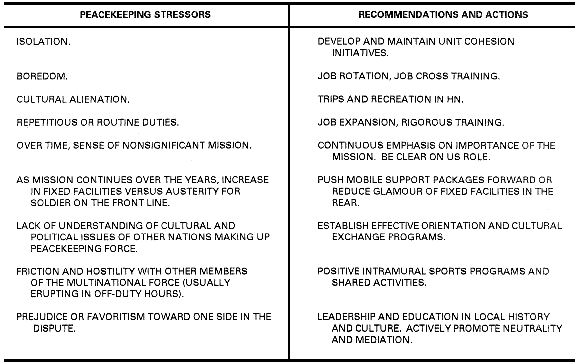
Go to Chapter 10 - War and the Integrated (Nuclear, Biological and Chemical) Battlefield
FM 22-51
LEADERS' MANUAL FOR COMBAT STRESS CONTROL
Table of Contents
Preface
Chapter 1 - Overview of Combat Stress Control
Chapter 2 - Stress and Combat Performance
Chapter 3 - Postive Combat Stress Behaviors
Chapter 4 - Combat Misconduct Stress Behaviors
Chapter 5 - Battle Fatigue
Chapter 6 - Post-Traumatic Stress Disorder
Chapter 7 - Stress Issues in Army Operations
Chapter 8 - Stress and Stressors Associated with Offensive/Defensive Operations
Chapter 9 - Combat Stress Control in Operations other than War
Chapter 10 - War and the Integrated (Nuclear, Biological and Chemical) Battlefield
Chapter 11 - Prevention of Battle Fatigue Casualties and Misconduct Stress Behaviors
Appendices
Appendix A - Leader Actions to Offset Battle Fatigue Risk Factors
Appendix B - Organization and Functions of Army Medical Department Combat Stress Control Units
Appendix C - United States Army Bands
Appendix D -The Unit Ministry Team's Role in Combat Stress Control and Battle Fatigue Ministry
Appendix E - Example Lesson Plan
Glossary - Abreviations and Acronyms
References - Sources Used
Write to us at Patriot Outreach, PO Box 601, Selma, OR 97538
or
Call Toll Free: 1-866-96-STRONG (866-967-8766) (8am to 4pm Pacific Time) Email: info@PatriotOutreach.org
Copyright 2006-2011 Patriot Outreach